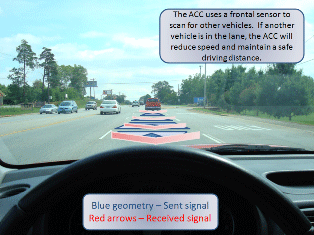Adaptive Cruise Control Systems
- Basic Description
-
Adaptive Cruise Control (ACC) extends existing cruise control systems to include a headway sensor that monitors the distance between your vehicle and the vehicle ahead.
The system is also sometimes called Active Cruise Control (ACC) or Intelligent Cruise Control (ICC).
ACC systems are similar to the conventional cruise control systems in the way they maintain the
vehicle preset speed. However, unlike conventional systems, ACC automatically adjusts the speed of
the vehicle in order to maintain a safe distance from vehicles ahead in the same lane.
The system automatically monitors road traffic patterns, employing a headway sensor
capable of detecting vehicles at distances up to 500 ft, and using the throttle and brakes to maintain a
pre-set distance behind the
vehicle ahead. When the road is clear again, the system re-accelerates to the pre-set velocity.


There are two key types of headway sensors.
Radar sensors employ microwave signals (typically at 35 or 76 GHz).
Lidar sensors employ a laser diode to produce infrared light signals. Both types of sensors send a signal and monitor the time required for the signal to reflect off the object ahead. Optical or infrared image sensors are also being introduced for the purpose of detecting vehicles on the road ahead. These sensors can replace or supplement the information from radar or lidar sensors.
When ACC systems determine there is a need to slow the vehicle, they may use the engine, transmission and/or brakes to decrease the vehicle's speed and maintain a safe following distance. Many systems limit the maximum deceleration to no more than 3 m/s2 (10 ft/s2), although systems are beginning to appear that allow more aggressive braking (see Automatic Braking). The ACC user interface typically has both visual and audible indications that are provided to the driver depending on the severity of the situation. ACC systems can always be disengaged through the use of the brake pedal or the primary ACC user interface. In addition, certain stability systems such as traction control, and electronic stability control may also turn the ACC system off.
ACC systems are evolving rapidly and are currently available on many mid- to high-end passenger cars as well as many heavy duty commercial trucks.
- Sensors
- Headway sensor (radar, lidar or image), vehicle speed sensor, accelerator pedal position, brake pedal position
- Actuators
- Throttle, brakes
- Data Communications
- Control Unit Communication: Typically Control Area Network (CAN) Bus System
- Manufacturers
- Autoliv, Bendix, Bosch,
Continental, Daimler, DAF, Delphi, Denso, MAN, Mobileye, Scania, TRW, Wabco
- For More Information
- [1] What is Adaptive Cruise Control and How Does It Work, Bill Howard, ExtremeTech.com, Jan. 23, 2015.
- [2] Autonomous Cruise Control System, Wikipedia.
- [3] Adaptive Cruise Control, Honda Website.
- [4] Automotive Adaptive Cruise Control Using FMCW Technology, Mathworks Website.
- [5] Chrysler Adaptive Cruise Control, YouTube, Nov. 19, 2012.
- [6] Adaptive cruise control│Ford How-To Video, YouTube, Jan. 03, 2013.
- [7] Audi's Autonomous Cruise Control - Traffic Jam Assist, YouTube, Jan. 09, 2013.
- [8] Adaptive Cruise Control and Traffic-Jam Assistants, Lucas Laursen, IEEE Spectrum, Apr. 30, 2014.
- [9] Mercedes-Benz DISTRONIC PLUS Adaptive Cruise Control Test - ABTL Auto Extras, YouTube, May 04, 2014.
- [10] I Drove A Car With 'Adaptive Cruise Control' And It Was Amazing, Matthew Debord, BusinessInsider.com, Sep. 09, 2014.
- [11] 2015 Chrysler 200 | Adaptive Cruise Control, YouTube, Oct. 29, 2014.
- [12] How Does Adaptive Cruise Control Work?, Jeremy Laukkonen, Cartech.about.com, 2015.
|

